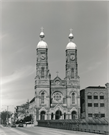| Additional Information: | A 'site file' exists for this property. It contains additional information such as correspondence, newspaper clippings, or historical information. It is a public record and may be viewed in person at the Wisconsin Historical Society, State Historic Preservation Office.
HABS WI-159. SEE HOUSES OF WORSHIP SURVEY. Formally organized in 1866, St. Stanislaus parish of Milwaukee was supposedly the third Polish parish in the U.S. and first in a metropolitan area. This parish supposedly founded the nation's first Polish-language elementary school. The church design is based on German architecture of the late Renaissance period and was created by a European-born and educated architect who came to this country in the 1840s. Schmidtner, believed to have been a member of the titled Von Kowalski family of Russia or Poland, opened an office in Milwaukee by the mid-1850s and practiced here until his death in 1875. The east front and most of the interion have been remodelled. The original copper-clad domes were replaced by golden domes in 1966.
In 1885, Henry Messmer designed $17,000 worth of renovations.
"St. Stanislaus, the city's first Roman Catholic Church, is one of Milwaukee's best-known architectural celebrities. Its spectacular, glimmering domes have been popular landmarks since they were gilded with 23 carat gold leaf in the early 1960s. Milwaukeeans have nicknamed St. Stanislaus the "church of the golden domes."
During the Baroque era of the seventeenth and eighteenth centuries, dome-topped churches were very popular in Poland. Milwaukee's Polish immigrants chose to reflect this very creative period in the design of St. Stanislaus. With its rounded window tops and domed towers St. Stanislaus is very different in style from the pointy, Gothic revival style churches historically preferred by the city's nineteenth century German-Americans.
The cornerstone was laid in July, 1872 and a portion of the church was dedicated the following year. Much of the major construction, however, was apparently done between the years of 1884 and 1894. The architect, Leonard Schmidtner, came to America in 1840 from Poland where he was a member of the nobility and known as Baron von Kowalski.
Several exterior remodeling projects have been completed since 1895, but the most extensive alterations were done in the early 1960s. This included gilding the copper domes, removing some wooden trim from the towers, completely remodeling the main entrance and installing a large mosaic of St. Mary of Czestochowa in the entry portal facing West Mitchell Street. The gold that covers the domes is actually thinner than a human hair and an ounce can cover a surface area of more than sixty square feet. After almost 30 years of exposure to the elements and acid rain, however, the domes need to be gilded again.
The interior has been altered several times over the years, most recently in a major remodeling begun in 1963, but it retains its original half-round arched ceiling, called a barrel vault which is a typical feature of Polish Baroque church architecture. Ornamental plaster work of exceptional quality and detail can be seen throughout the interior. The beautifully crafted marble and bronze trimmed altar is an outstanding example of the Poles' preference for church fittings made of finely worked stone. The stained glass windows were added in 1963.
St. Stanislaus was Milwaukee's first Polish-speaking parish founded in 1866 and only the third Polish parish established in the United States. It also has the distinction of being the first Polish Catholic Church established within a major American city. Until the present church was completed, the parishioners worshipped in a small building on the northwest corner of South Fifth and West Mineral Streets that had previously belonged to St. Stephen's Lutheran Church. Today, many different ethnic backgrounds are represented in the diverse congregation which takes great pride in its landmark church building." MILWAUKEE ETHNIC CHURCH TOUR, CITY OF MILWAUKEE DEPARTMENT OF CITY DEVELOPMENT, 1994. |
|---|
| Bibliographic References: | MILWAUKEE ETHNIC CHURCH TOUR, CITY OF MILWAUKEE DEPARTMENT OF CITY DEVELOPMENT, 1994.
BUILT IN MILWAUKEE, LANDSCAPE RESEARCH, P. 135.
Pagel, p. 18.
Milwaukee Sentinel 12/27/1885, 12/5.
Cornerstone.
Pagel, Mary Ellen & Virginia A. Palmer, University Extension University of Wisconsin, Guides to Historic Milwaukee: Walker's Point and South, 1969. |
|---|





